Arizona’s Grand Canyon Greenway Trail
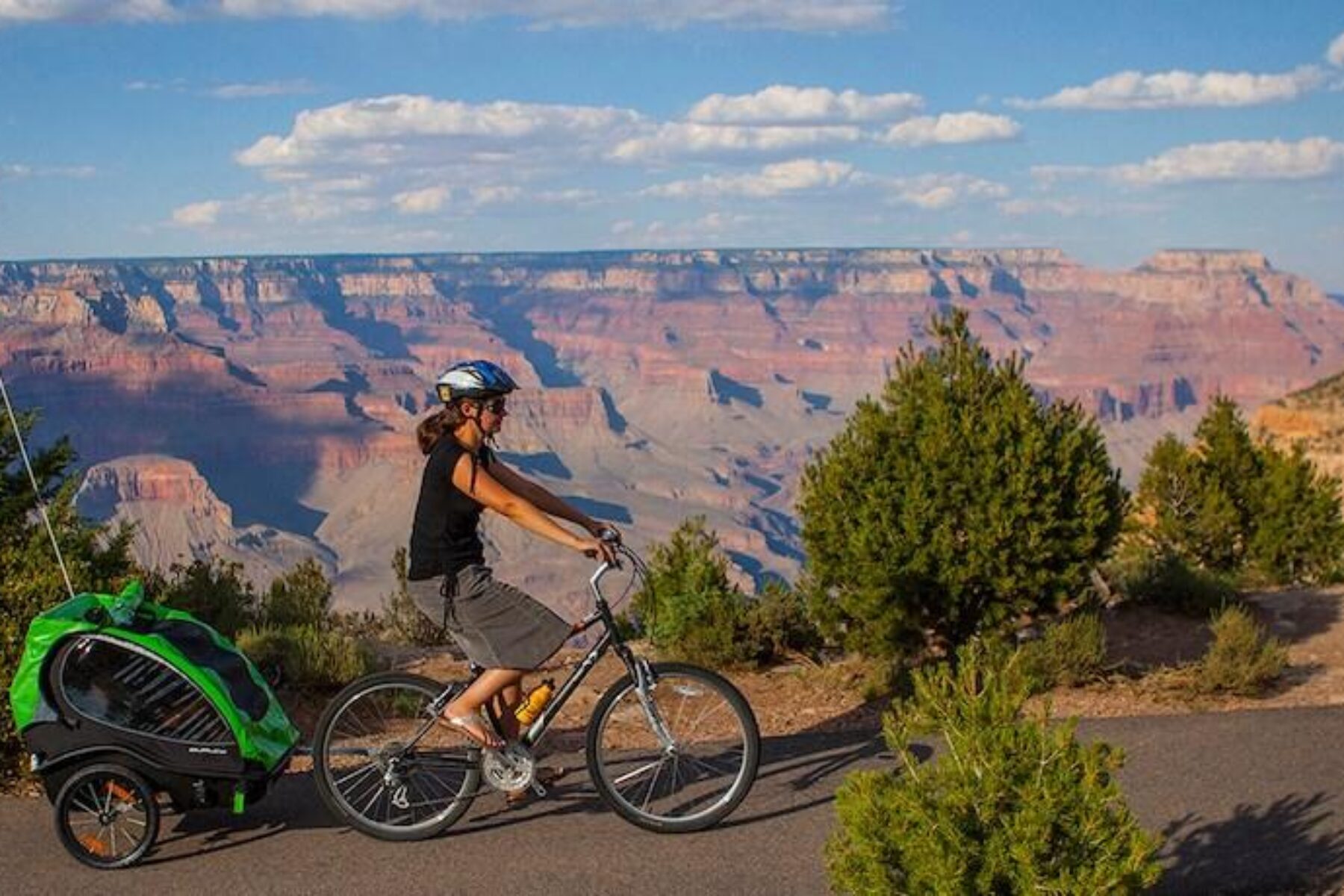
Trail of the Month: October 2019
“People talk about how enjoyable it is that this trail is available and allows them to get out and really experience the canyon.“
—Chuck Flink, president of Greenways, Inc.
In Grand Canyon National Park, which sees more than 6 million visitors each year, the park’s greenway trail system offers a delightful way to connect travelers to those quiet moments where they can take in the awe-inspiring beauty that surrounds them. All told, Arizona’s Grand Canyon Greenway Trail totals 13 miles of paved pathway for biking and walking, providing access to numerous scenic viewpoints and attractions in the park.
“The greenway trails are a tremendous asset to the park,” said Vicky Stinson, a project manager for Grand Canyon National Park. “And bicycling is a welcome part of the park’s overall transportation system.”
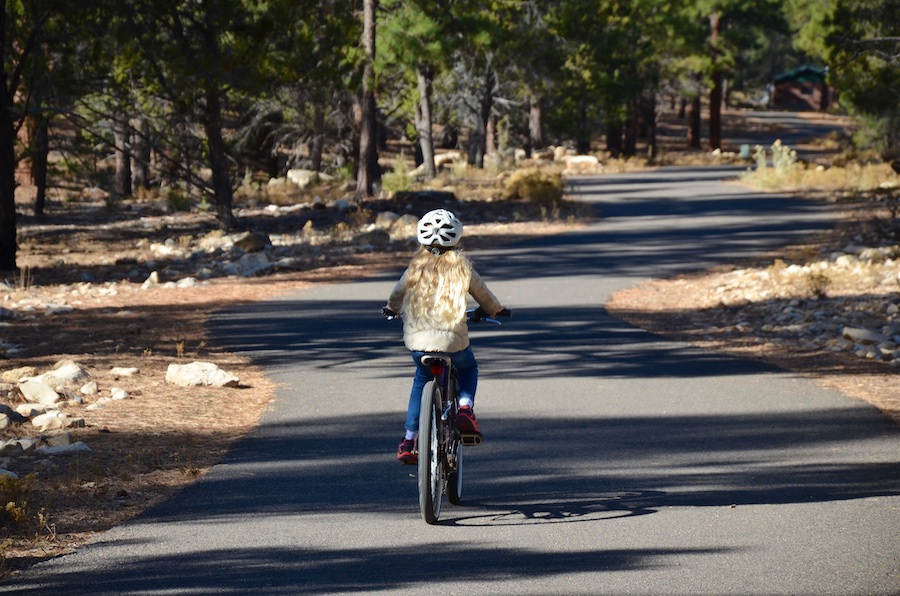
Pedaling along the park’s greenway trail system, visitors are immersed in the scenery. Winding through ponderosa, pinyon and juniper forest, adventurers will often not only have a rim-side view of the canyon, they’ll also have a good chance to see wildlife, such as elk, bighorn sheep, mule deer, gray foxes and one of North America’s largest birds, the California condor (with a wingspan of 9+ feet!).
With the greenway trail’s seamless integration with the park’s free shuttle bus service—including buses with bike racks—tourists can reach lodging, restaurants and shops in and around the park without a car, a perfect meeting of transportation and recreation needs. Not to be overlooked is the benefit the trail system provides to locals as well.
“The South Rim is a densely populated 3-mile stretch along the rim of the Grand Canyon,” said Stinson. “It’s a small city, so there’s a K-12 school and about 2,000 full-time residents that can use the greenway.”
A Grand Adventure
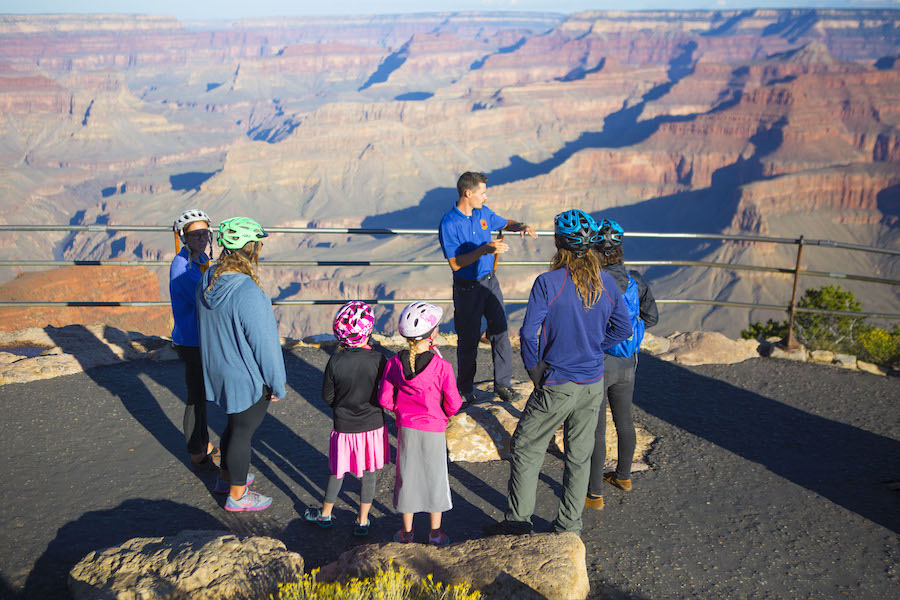
President Theodore Roosevelt, who visited the Grand Canyon in 1903 (nearly a decade before Arizona was even a state), once said of the canyon, “It is beyond comparison—beyond description; absolutely unparalleled throughout the wide world.” With its unique rock formations and multihued gorge stretching as far as the eye can see, it’s not hard to see why it was later added to the list of World Heritage Sites, one of only 24 such places in the country.
Numerous spots to take in those views can be found along the greenway trail, some of which are inaccessible to cars. “There’s one area that we called the ‘money spot’ during trail construction because it’s this location where you have this fantastic view looking straight up the river,” said Stinson of the greenway section along Hermits Road, a scenic route used by shuttle buses but closed to private vehicles for most of the year.
“For a lot of people that travel a long distance to see the Grand Canyon, their user experience used to be really short,” said Chuck Flink, who was involved early on in the development of the Grand Canyon Greenway Trail in the late 1990s and into the 2000s. “Their time actually looking at the Grand Canyon, prior to this greenway system, was a just a few minutes. They’d be offloaded from tour buses, take a look at the view and then they’d be back on the buses, driving out of the park. We wanted to figure out a way to not only extend that visitation experience but also to get away from the crowded overlooks and provide people with an opportunity to really experience the Grand Canyon—to feel the wind and to hear the wildlife—and a linear trail can do that.”
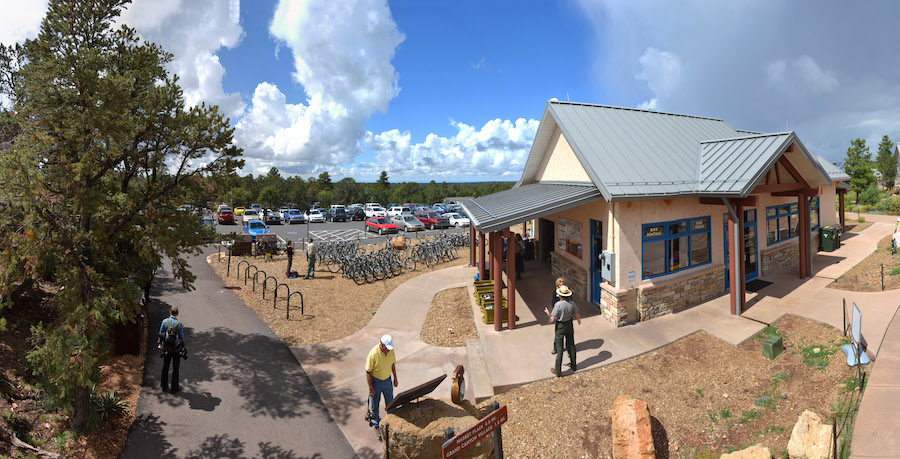
To explore the canyon’s South Rim, the bike rental service provided by Bright Angel Bicycles, nestled against the park’s visitor center at Mather Point, offers a convenient place to grab a set of wheels. As the greenway trail developed through the 2000s, the National Park Service sought a business that could provide bike rentals to meet demand for the new recreational opportunity in the park. Bright Angel Bicycles became that official partner in 2012 and, since then, has doubled its fleet of bicycles, according to the shop’s co-owner Wes Neal.
“The last part of our bike tour is this fun downhill cruise into Hermits Rest, where you’ve got the wind in your face and it’s just exhilarating,” said Neal. “You’ve got the Grand Canyon cruising by on your right, and it’s beautiful. People get so enthused by that—they’re like, ‘I’ve got to get back on my bike when I get home!’”
For those who want to combine their biking experience with a hike into the canyon, the South Kaibab and Bright Angel Trails are easily accessible from the greenway trail. Just be sure to bring water, and follow the park’s hiking tips before venturing out, as these dirt paths are steep and challenging.
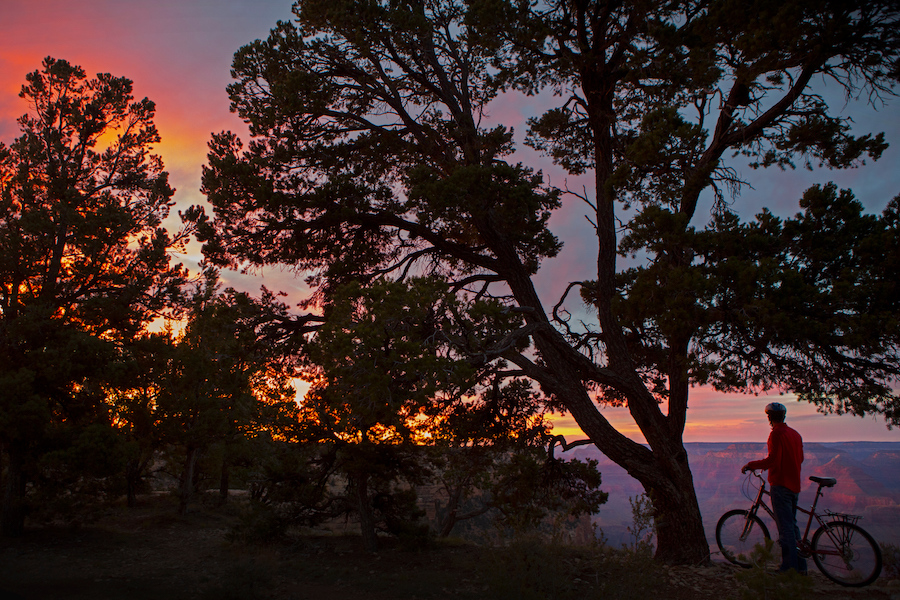
And the adventure doesn’t have to stop when the sun goes down. Just last month, Grand Canyon National Park was named the International Dark Sky Place of the Year for its “tremendous strides to protect the night over the last several years.” Spanning 1.2 million acres, the Grand Canyon is the largest Dark Sky Park in the world. Its South Rim entrances are open 24 hours, offering opportunities to witness the canyon’s unforgettable starry spectacle. Each June, the park also hosts the largest astronomy event in the National Park Service: the Grand Canyon Star Party, providing nightly astronomy programs and telescope viewing over several days.
Trail as Old as Time
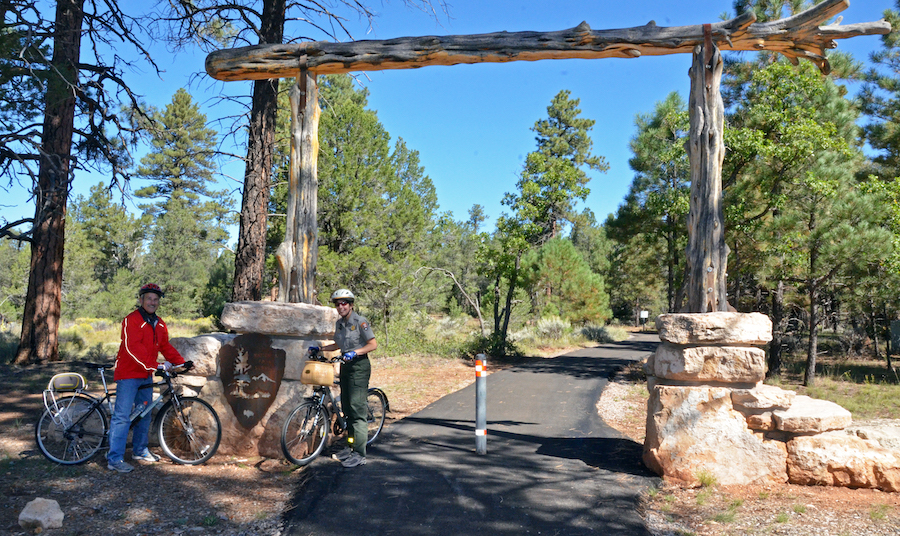
To learn more about the park’s fascinating landscape, a visit to the Yavapai Museum of Geology makes for a worthwhile stop; from the visitor center, travelers can take the paved, pedestrian-only Rim Trail (or the shuttle bus) for about a mile to reach it. From the museum, a walking path stretching westward illuminates the geologic history of the canyon through interpretative panels—each meter of this “Trail of Time” signifying the passing of 1 million years.
Numerous touchpoints to human history are also available just off the greenway trail in the Grand Canyon Historic Village, where there are many early-20th-century buildings and National Historic Landmarks to explore; a walking tour map of the village can be picked up at the visitor center. Railroad history buffs may even want to enter the park on the Grand Canyon Railway along tracks that first opened in the park in 1901. The trains run daily from Williams, Arizona, and drop off passengers at the Grand Canyon Depot, one of only a handful of stations remaining in the U.S. that were built with logs.
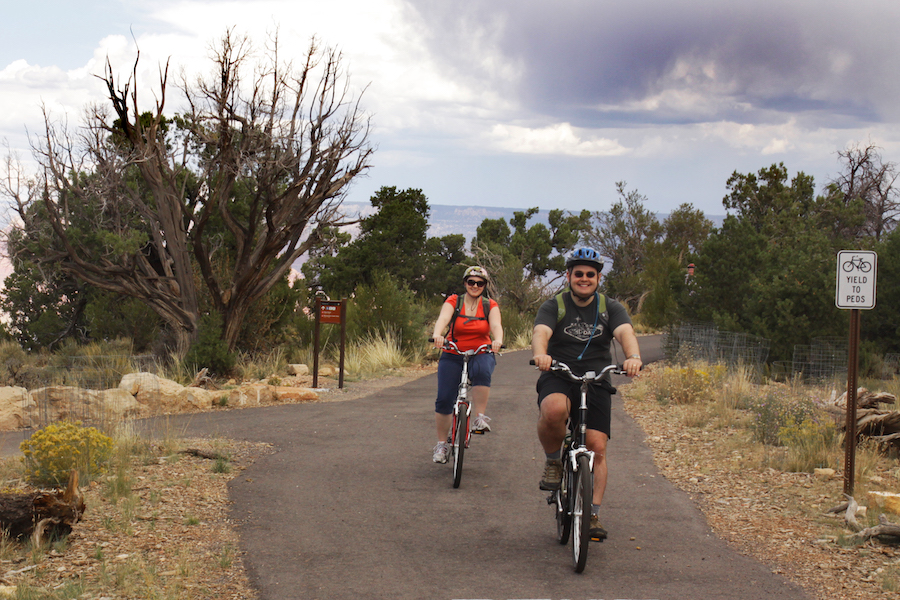
As the park celebrates its 100th anniversary this year, it’s worth taking a look back at how the greenway trail found its footing here. The park’s General Management Plan in 1995 originally laid out a proposal for more than 70 miles of multiuse trails across both the South Rim and the North Rim. But the Grand Canyon Greenway Trail project really grew legs in 1999 when it was dedicated as a part of the Millennium Trails Initiative, a forward-looking effort to spark growth in America’s trail movement in celebration of the year 2000; Rails-to-Trails Conservancy was a partner on the national initiative.
Six phases of the greenway trail were constructed over more than a decade with the aid of a volunteer group of greenway planners, designers and advocates who were essential to its development. One of the project’s big selling points was the reduction of the environmental impact of so many park visitors.
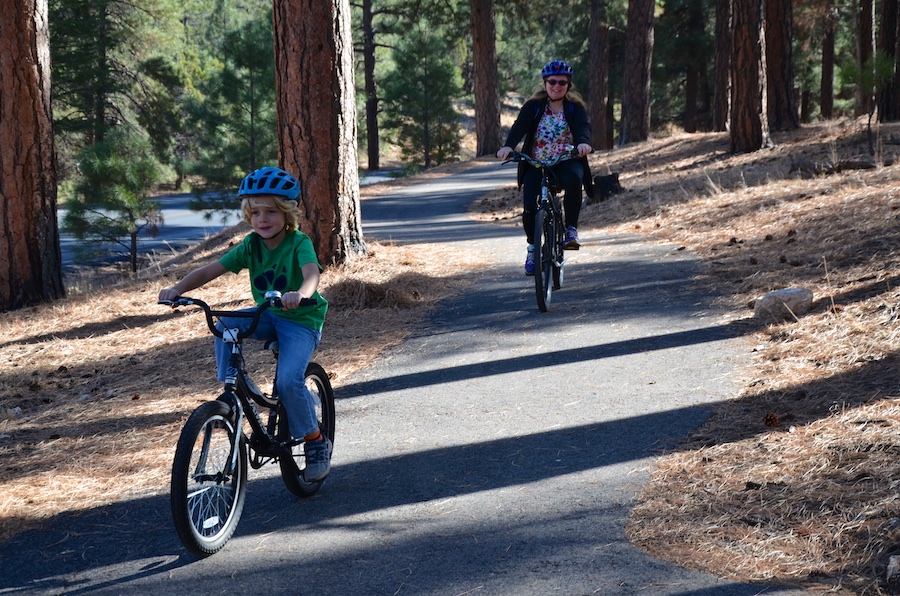
“We pointed to the fact that there were 5 million visitors to the South Rim, but there were no trails, no way to get around as a pedestrian,” said Flink, who is now owner of Greenways, Inc. “You got on buses or you drove cars, as that’s the way our National Parks were designed, but that was not an acceptable way for a lot of people to view the Grand Canyon, so they were just going off across the countryside through the High Desert landscape, and there were braided trails everywhere. These human-carved trails were transforming the South Rim’s Coconino layer [a type of sandstone] into a dust storm—it was like talcum powder—so the greenway trail was a chance to organize all of this movement onto a single track and provide an asphalt surface that could take the impact.”
Looking back, Flink is proud of the greenway trail’s success and hopes it can serve as a model to be replicated in other National Parks. “People talk about how enjoyable it is that this trail is available and allows them to get out and really experience the canyon,” Flink said. “Through the years, there’s been tremendous positive feedback from the public—the project’s been positively received ever since it was first announced.”
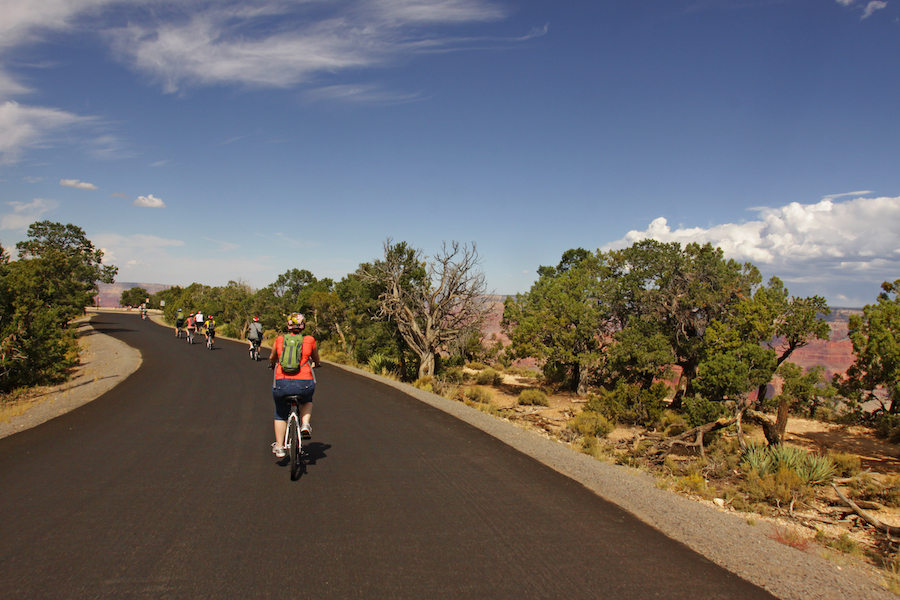
Related Links
Trail Facts
Name: Grand Canyon Greenway Trail
Trail website: Grand Canyon National Park
Length: The park offers 13 miles of paved, multiuse greenway trail.
County: Coconino
Start point/end point: Running east–west, the park offers a 4.4-mile route from the Village Loop Drive and Hermit Road intersection in the Grand Canyon Village to the South Kaibab Trailhead (off Yaki Point Road). At roughly its midpoint, an additional 6.6 miles of paved greenway trail heads south from the Grand Canyon Visitor Center to the park’s gateway community of Tusayan. Farther west and disconnected from the rest, an additional 2 miles of paved greenway parallels Hermit Road between Monument Creek Vista and Hermits Rest (where there is a small gift shop and snack bar).
Surface type: Asphalt
Grade: The greenway trail along the South Rim is relatively easy and level. However, note that the north–south trail has an uphill grade as you travel north from Tusayan to the park; since the South Rim is at high altitude (7,000 feet), the extra exertion of this ascent may prove challenging for novice riders.
Uses: Walking, bicycling and inline skating; wheelchair accessible
Difficulty: The greenway trail system provides a paved, family-friendly way to get around Grand Canyon National Park without a car.
Getting there: The closest commercial airport is Flagstaff Pulliam Airport (6200 S. Pulliam Drive, Flagstaff), about 90 miles from Grand Canyon National Park. Amtrak also has a stop in the city—Flagstaff Station (1 East Route 66 in Flagstaff)—on its Southwest Chief route between Chicago and Los Angeles.
Another option is to ride the Grand Canyon Railway into the park from Williams (about 30 miles west of Flagstaff). The rail line, in operation since 1901, uses restored rail cars and entertains passengers with musicians and Old West characters. The trip takes just over two hours each way.
Farther out, Phoenix Sky Harbor International Airport (3400 E. Sky Harbor Blvd., Phoenix), lies about 230 miles from the park.
Access and parking: Admission to Grand Canyon National Park lasts for seven days and costs $35 per private vehicle, $30 per motorcycle, or $20 per person when entering by foot, bicycle, park shuttle bus, Grand Canyon Railway or private rafting trip. Children 15 years old and younger are free, and the park also offers a handful of “Fee-Free Days” for all ages each year.
Parking is available at the Grand Canyon Visitor Center at Mather Point on the South Rim. This is a good place to begin your journey on the greenway trail as the visitor center offers exhibits, park ranger programs and Bright Angel Bicycles (which houses a café in addition to bike rentals and tours). At the visitor center and throughout the park, you will also find stops for the park’s free shuttle bus system; buses include bike racks, so you can bike one way on the trail, then take the shuttle back. Additional parking lots can be found in Grand Canyon Village at the Market Plaza and in the Village Historic District.
To navigate the area with an interactive GIS map, and to see more photos, user reviews and ratings, plus loads of other trip-planning information, visit TrailLink.com, RTC’s free trail-finder website.
Rentals: Bicycles can be rented from Bright Angel Bicycles (10 South Entrance Road, Grand Canyon; 928.679.0992), adjacent to the Grand Canyon Visitor Center. They offer both adult and children’s bikes, trailers and wheelchairs with 1-hour, half-day, full-day and multiday rental options; strollers are also available for rent.

Donate
Everyone deserves access to safe ways to walk, bike, and be active outdoors.
